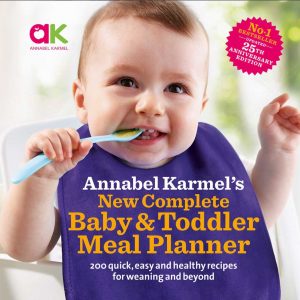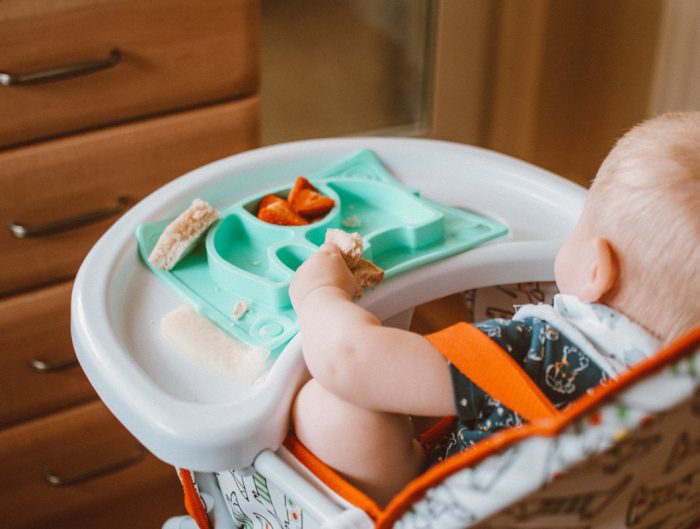
Starting solid foods
Readiness for starting solid foods:
As your baby starts to approach 6 months of age, you will probably be thinking of introducing solid foods into his diet. Up until this point your milk has been adequate to meet all his nutritional requirements, but as he becomes more active, his nutritional demands start to change.
Signs that your baby is now ready to start solid foods are:
1. ability to hold his head up for prolonged periods when in a seated position
2. loss of the tongue thrust reflex (pushing out an empty spoon when it is placed inside the mouth)
3. Getting more interested in solid food- oftentimes babies will try to snatch daddy’s food from his plate!
At what age should you start solid foods?
You should aim to start your baby on solids by around 6 months. We usually recommend that parents avoid starting solids before 4 months (16 weeks), unless in certain medical conditions. However, you should try not to delay starting solids beyond 6 and a half months. Studies show that there are specific developmental “windows” during which your baby is open to learning the skills of chewing and tolerating solid and textured foods: if you delay starting solids much beyond this time, your baby may be at risk of developing oral hypersensitivity and a dislike of or reduced tolerance for solids or textured foods.
How to start, or “first tastes”:
Once you have determined that your baby is interested in food, you can choose a time during the day when your baby is not too tired or hungry. Around an hour before his usual lunchtime milk feed is usually a good time to start.
You may wish to start with a plain baby rice mixed with some of his normal milk in a bowl. Avoid adding rice cereal to a milk bottle; it is difficult for your baby to suck through the narrow hole in the teat, and it stops your baby from learning the important skill of taking food from a spoon. When choosing a rice cereal, try to choose one with no added salt or sugar; as a general rule, don’t add salt or sugar to your baby’s food for the first 12 months of life.
Other good first foods to start with are single ingredient fruit or vegetable purees such as apple, pear, carrot, sweet potato or butternut squash. You can steam and then blend them to a smooth consistency (adding some of the steaming water or his usual milk as desired to thin the puree if necessary). Allow the puree to reach a comfortable room temperature before serving.
Table Manners:
It is never too early to introduce good table discipline: in fact the earlier you start the easier it is to encourage your baby to adopt good practices.
You should always feed your baby in his high chair at the table, rather than trying to coax him into eating whilst he is playing or in front of the television.
Try to time your baby’s meals so that they coincide with family meal times as much as possible, or at least eat a snack or your own meal at the same time. This encourages your baby to understand that eating at the table is normal, and reinforces the positive social impact of eating together as a family.
What To Give:
Introduce new tastes every three days, allowing yourself a couple of days between the introduction of each new ingredient to observe for signs of allergy or intolerance. Once your baby has a good repertoire of tastes you can start to combine them to add interest and variety.
By the time your baby is around seven months, or has been taking fruit and vegetable purees for a few weeks, you can start adding protein into his diet. Good sources of protein to start with are chicken and oily fish such as salmon, which are high in omega 3 oils.
From around seven to eight months, you can start adding carbohydrates in the form of tiny pasta shapes or soft rice (risottos). This allows your baby to experience some soft lumps and texture in the food. It is important to allow your baby to start to experience some more textures from around 8 months to teach chewing and swallowing skills. Again, do not delay this too long beyond 8 months so as to avoid your baby developing aversion to textured solids.
Your baby may dislike textures and even gag initially; continue to offer the textured food in small spoonfuls up to ten times per feed until your baby becomes gradually more tolerant. If your baby continues to reject textured solids, try pureeing half the food and mixing in more lumpy textured food to the puree.
Further Reading

A useful resource for advice on how to wean your baby, as well as lots of lovely recipes to try can be found at www.annabelkarmel.com. Annabel Karmel also has many books available on weaning and childhood nutrition.
What challenges did you face when starting solids with your child? What tricks and tips did you find helpful? Feel free to share your comments below. If you enjoyed reading this article, remember to enter your email in the box above to subscribe to receive weekly blogs direct to your inbox. Have a great week ahead!



4 Comments
Great article, thank you! I started my Son on solids at 19 weeks as he seemed ready however now more than a month down the track he is still not taking to them. He is extremely happy to sit with us at the table, watch us eat and even open his mouth for the first taste but thats it, not more than a teaspoon total goes in. We offer more but have not forced him. Not sure if I should start proteins or hold off (so far only fruit and veg, and not sure even that counts). We also offer finger food but that ends up on the floor 🙂
Hi Ivana,
Well done for feeding your son at the table with the family; this way he can observe how you eat and pick up social cues. Try not to worry about how much he’s eating at this stage- continue to offer a range of purees and finger foods, and feel free to add proteins at this stage. Continue with his usual milk feeds, and he will increase the solids as he is ready. All the best! 😊
Hi Dr Natalie,
Hope you are well! You used to look after my kids Kai and Zoe, we Moved to California a few months ago. I regularly check on your articles as they are always so helpful! Regarding the above, Zoe who’s now 8 months is still barely eating solids. At almost 7months she was still pushing the food out of her mouth and not swallowing more than 3 spoons. Now she still barely eats. I tried cereals in milk, fruits and veg purées, she just doesn’t seem keen. She looks at the spoon and doesn’t open her mouth, or she thinks it’s a toy and grabs the spoon. She also doesn’t look that keen to grab the food from my mouth when I est and show her how I do..
Could there be an issue or is she just a “late”solid eater? Anything I should be doing to get her keen to eat?
Thanks a lot!
Hi Sophie,
Firstly, don’t panic. In the first year of life, introduction of solids is still regarded as supplemental to the milk, which remains the primary source of nutrition until 12 months.
Continue to keep mealtimes fun, and stress-free. Provide positive role models in the form of parents and her older sibling- the social context of mealtimes is crucially important.
Don’t be tempted to distract Zoe to “sneak in” some food. Rather, allow her to explore tastes and textures in a relaxed and stress-free environment. Try offering a combination of finger foods and purées, and try to offer similar foods to those she sees Kai eating.
You can also offer age-appropriate foods from your plate- try pieces of banana or avocado mushed on your fingertip.
Continue to offer a wide variety of different foods, and remain positive and happy throughout mealtimes. Remember, it is your job to provide healthy, age-appropriate foods, and it is her job to explore and learn to take these.
Take a deep breath and remember to enjoy the ride!
Dr Natalie